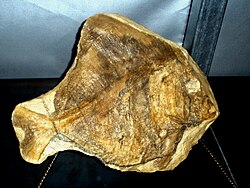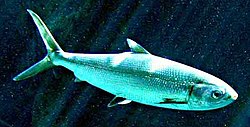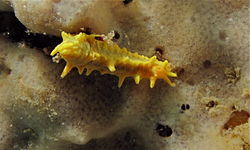Top Qs
Timeline
Chat
Perspective
Tlayúa Formation
Geologic formation in Mexico From Wikipedia, the free encyclopedia
Remove ads
The Tlayúa Formation is an Cretaceous Konservat-Lagerstätte near Tepexi de Rodríguez, Puebla, Central Mexico.[1] It consists of three members (Lower, Middle and Upper), spanning the lower Albian of the Early Cretaceous to the lower Cenomanian of the Late Cretaceous. It consists of a series of limestone quarries that preserve lagoonal palaeoenvironments, such as a shelf lagoon, a shallow lagoon surrounded by a peneplain, and a tidal flat. It is notable for preserving high quantities of vertebrate and invertebrate fossils, and is thus considered a Lagerstätte.
Remove ads
Description
Summarize
Perspective
The Tlayúa Formation was first described by Jerjes Pantoja-Alor in 1992.[2] It is located in the Tlayúa ravine, which itself lies in the southern portion of Puebla, Central Mexico, near Tepexi de Rodríguez,[1] and consists of a series of limestone quarries that has seen commercial use for decades.[3]
Stratigraphy
The Tlayúa Formation consists of two stratigraphic units (Tlayúa and Barranca Abuelo)[4] and three members. The Lower Member is lower Albian in age. It consists of bioturbated limestones, and is characterised by the presence of the non-rudist bivalve Chondrodonta and the rudist bivalve Toucasia polygyra. The Middle Member, corresponding to the Tlayúa Quarry, is the most fossiliferous.[3] Its age has been difficult to ascertain, as the foraminiferan Spiroloculina cretacea is known exclusively from lower Cenomanian strata,[5] though it has since been determined to be Upper Albian.[3] The Middle Member consists of fine-grained lithographic limestones, interspersed with hematitic layers that preserve its vertebrate fauna. The Upper Member is Cenomanian in age, and consists of a sequence of dolomites. It is characterised by the presence of the miliolid foraminiferan Dicyclina schlumbergi.[3]
Depositional environments
The depositional environment of the Tlayúa Formation was likely a shallow, coastal lagoon,[6] with some freshwater influence, as indicated by the presence of crocodilian and turtle fossils.[6][7] The Lower Member of the Tlayúa Formation represents a carbonate environment which apparently had stressed biodiversity.[4] The depositional environment of the Middle Member was likely arid for much of the year, with the exception of seasonal rains and storms.[7] The Upper Member likely represents a tidal flat.[4] The Tlayúa Formation may have been part of an island, though a connection to the North American mainland cannot be discounted.[7]
Remove ads
Paleobiota
Summarize
Perspective
The formation contains a diverse array of vertebrate and invertebrate fossils. For this reason, it is considered a Konservat-Lagerstätte.[4][7] About 70% of the macrofossils are osteichthyan fish.[8] Other vertebrates include chelonians, pterosaurs, lepidosaurs, and crocodiles.[9] Cyanobacteria, foraminifera, algae, gymnosperms, sponges, cnidarians, annelids, gastropods, ammonites, bivalves, arachnids, insects, isopods, anomurans, brachyurans, crinoids, echinoids, holothuroids, stelleroids, and ophiuroids, have also been recovered from the Tlayúa Formation.[9][10][11]
Archelosaurs

The remains of several indeterminate archelosaur taxa have been recovered from the Tlayúa Formation. Indeterminate crocodilians and turtles have been identified.[6][7] Partial, articulated wings of an unidentified pterosaur have been discovered from the formation. Though tentatively assigned to Pteranodon sp. and Nyctosaurus sp. in 2008,[12] they likely represent either an early azhdarchoid or an indeterminate ornithocheiromorph.[13]
Lepidosaurs
Fish
Mainly after González-Rodríguez (2016)[18] and Applegate et al. (2006)[3]
Arthropods
Echinoderms
Mollusks
- Inoceramus sp.
- Pectinidae indet.
- Osteridae indet.
- Gastropoda indet.
- Neohibolites minimus obtusus
- Neohibolites minimus pinguis
- Neohibolites minimus claviformis
- Neohibolites praeultimus
- Mesohibolites semicanaliculatus
- Martoniceras sp.
- Hysteroceras sp.
- Anisoceras sp.
Other invertebrates
Plants
- cf. Araucaria sp.
- cf. Frenolopsis
- Brachyphyllum sp.
- Podozamites sp.
- Zamites sp.
- Phaeophyceae
Remove ads
References
Further reading
Wikiwand - on
Seamless Wikipedia browsing. On steroids.
Remove ads





























